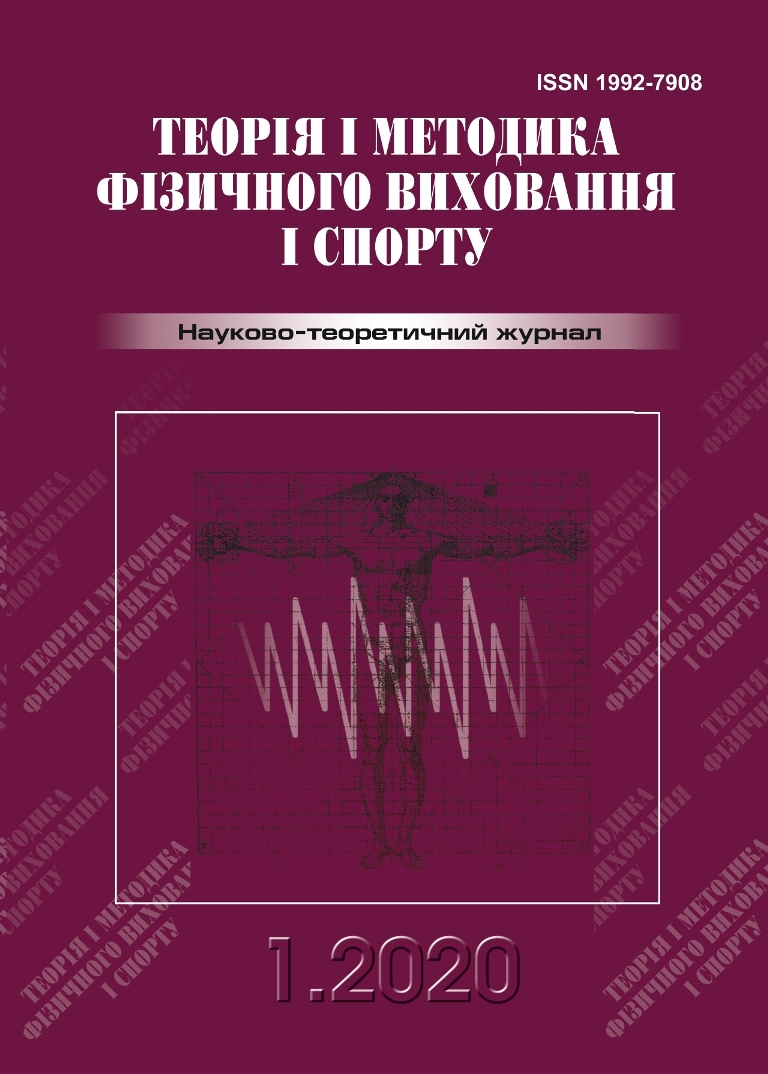DIAGNOSTICS OF HUMAN MOTOR FUNCTION IN PHYSICAL REHABILITATION
DOI:
https://doi.org/10.32652/tmfvs.2020.1.42-48Ключові слова:
біомеханічний аналіз, кінематичні характеристики, рухова дія, реабілітація, програмне забезпеченняАнотація
Анотація. Використання технології біомеханічного відеокомп’ютерного аналізу є ефективним у діагностиці порушень рухової функції людини. Більшість комп’ютерних програм, які використовуються у фізичній реабілітації, є засобами автоматизації обчислень показників фізичного стану, водночас проблема розробки прикладного програмного забезпечення комп’ютеризованих вимірювальних систем для оперативного й об’єктивного аналізу рухових дій людини залишається актуальною.Мета. Розробити програмне забезпечення біомеханічного відеокомп’ютерного аналізу рухової функції людини у фізичній реабілітації.
Методи. Біомеханічний відеокомп’ютерний аналіз кінематичних характеристик рухових дій людини.
Результати. Розроблено прикладне програмне забезпечення «БіоВідео», що включає чотири модулі: 1) конструювання моделей опорно-рухового апарату людини; 2) визначення координат точок відносно соматичної системи відліку; 3) розрахунок біомеханічних характеристик рухової дії (програмні можливості модуля дозволяють розраховувати локалізацію центрів мас біоланок і загального центру мас тіла людини); 4) побудова біокінематичної схеми тіла людини за відеограмою рухових дій з визначенням траєкторій руху центрів суглобів, центрів мас біоланок і загального центру мас тіла людини. У покадровому та фазовому аналізах визначаються такі біомеханічні характеристики: горизонтальна, вертикальна та результуюча лінійні швидкості загального центру мас і центрів мас суглобів тіла людини; амплітуда кутів суглобів та кутова швидкість біоланок тіла спортсмена; часові характеристики; потенційна, кінетична, повна енергії окремих біоланок і всього тіла людини. Програмне
забезпечення «БіоВідео» призначене для отримання якісної і кількісної інформації про рухову функцію людини, яка служить основою для розробки реабілітаційних програм. Ефективність розробленого програмного забезпечення «БіоВідео» у діагностиці рухової функції людини підтверджена клінічними дослідженнями.
Посилання
Bernstein NA. About the motion structure. Moscow, Medgiz, 1947.
Laputin AN. Didactic biomechanics: problems and solutions. Science in Olympic Sport. 1995; 2(3): 42–51.
Adyrkhaeva LV. Substantiation of physical culture tools for the development of physical activity of young people with disabilities: Scientific journal National Pedagogical Dragomanov University. Series 15: Scientific and pedagogical problems of physical culture (physical culture and sports). 2016; 02 (69): 11–15.
Yukhno YA, Khmelnitska IV. Information technology in physical rehabilitation: Scientific journal National Pedagogical Dragomanov University. Series 15: Scientific and pedagogical problems of physical culture (physical culture and sports). Кyiv, 2017. Issue 11 (93). P. 129–138.
Adyrkhaev Soslan, Adyrkhaeva Liudmyla, Radzeviciene Liuda. Main Areas of Physical Education during University Professional Training and Rehabilitation of Students with Disabilities. Development Prospects of the systemof vocational Rehabilitation of people with Disabilities. Siauliai, Lithuania, 2015. P. 121–130
Alana Elza Fontes Da Gama, Thiago de Menezes Chaves, Pascal Fallavollita, Lucas Silva Figueiredo, Veronica Teichrieb. Rehabilitation motion recognition based on the international biomechanical standards. Expert Systems with Applications. Volume 116, February 2019, Pages 396–409. https://doi.org/10.1016/j.eswa.2018.09.026
Andrea Greisberger, Brigitte Wolf, Klaus Widhalm, David Kollmitzer, Maximilian Arbesser, Peter Putz. Intrarater and Interrater Reliability of Angular Measures Using TEMPLO Two-dimensional Motion Analysis Software. Journal of Manipulative and Physiological Therapeutics. Volume 42, Issue 6, July 2019, Pages 425–429. https://doi.org/10.1016/j.jmpt.2018.11.018
Chandran K.R.Sarath, Premanand Venkatesh. Hardware – software co-design framework for sum of absolute difference based block matching in motion estimation. Microprocessors and Microsystems. Volume 74, April 2020, 103012 https://doi.org/10.1016/j.micpro.2020.103012
Christe G, Redhead L, Legrand T, Jolles BM, Favre J. Multi-segment analysis of spinal kinematics during sit-to-stand in patients with chronic low back pain. J Biomech. 2016;49(10):2060–2067. PubMed ID: 27262182 doi:10.1016/j.jbiomech.2016.05.015
Donlon, T, Franklin, B, Machamer, C, Mogelnicki, C, Verneus, J, & Taber, C B (2018). FMS squat assessment and 2D video motion analysis as screening indicators of low back pain: A cross sectional case-study. Journal of Exercise Science & Physiotherapy Vol. 14(2), 1–10. doi: 10.18376/jesp/2018/v14/i2/111300
Ehara Y, Fujimoto H, Miyazaki S, Tanaka S, Yamamoto S. Comparison of the performance of 3D camera systems. Gait Posture. 1995;3(3):166–169. doi:10.1016/0966-6362(95)99067-U
Giannotti E, Merlo A, Zerbinati P, Prati P, Masiero S, Mazzoli D Safety and long-term effects on gait of hemiplegic patients in equinovarus foot deformity surgical correction followed by immediate rehabilitation: a prospectiveobservational study. European Journal of Physical and Rehabilitation Medicine, 27 Aug 2018, 55(2):169–175 DOI: 10.23736/s1973-9087.18.05290-5 PMID: 30156087
Hodges PW, Smeets RJ. Interaction between pain, movement, and physical activity: short-term benefits, longterm consequences, and targets for treatment. Clin J Pain. 2015;31(2):97–107. PubMed ID: 24709625 doi:10.1097/AJP.0000000000000098
Kashuba V, Khmelnitska I. The Biovideo Software for Biomechanical Analysis of Human Movement. Proceedings of 12th Annual Congress of the European College of Sport Science. Jyväskylä, Finland. July 11–14, 2007. P. 67–69.
Krupenya S V, Khmelnitska I V. Тechnology of biomechanical analysis in sport disciplines teaching. Project approach and educational innovations in the context of integration into the European education area: the collection of materials of the International scientific and practical conference (March 21, 2018, Lodz) [Electronic resource]. Poland: Lodz, 2018. Р. 133–135. ISBN 978-83-64838-22-4
Laputin A N, Khmelnitska I V. Mastering of Biodynamic Structure of Complex Motional Acquirement by Means of Directional Correction of Human Body’s Gravitation Interactions. Proceedings of the ninth Biomechanics Seminar, 1995. Centre for Biomechanics. Chalmers University of Technology and Gothenburg University. April 27–28, 1995.
Needham R, Stebbins J, Chockalingam N. Three-dimensional kinematics of the lumbar spine during gait using marker-based systems: a systematic review. J Med Eng Technol. 2016;40(4):172–185. PubMed ID: 27011295 doi:10.3109/03091902.2016.1154616
Vincent Samy, Ko Ayusawa, Yusuke Yoshiyasu, Ryusuke Sagawa, Eiichi Yoshida. Fusion of Multiple Motion Capture Systems for Musculoskeletal Analysis. 2020 IEEE/SICE International Symposium on System Integration, Jan 2020, Honolulu, United States. ⟨hal-02433191⟩
Yang N, An Q, Yamakawa H, Tamura Y, Yamashita A, Asama H. Muscle synergy structure using different strategies in human standing-up motion. Adv Robot. 2017;31(1–2):40–54. doi:10.1080/01691864.2016.1238781
Zia, A, Sharma, Y, Bettadapura, V et al. Video and accelerometer-based motion analysis for automated surgical skills assessment. Int J CARS 13, 443–455 (2018). https://doi.org/10.1007/s11548-018-1704-z
##submission.downloads##
Опубліковано
Номер
Розділ
Ліцензія
Авторське право (c) 2020 Теорія і методика фізичного виховання і спорту

Ця робота ліцензується відповідно до Creative Commons Attribution 4.0 International License.

